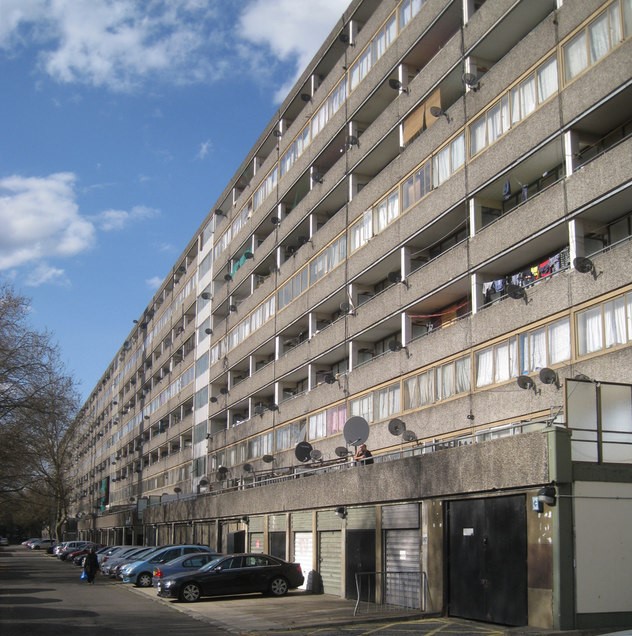Medium-rise building

|
| 10-storey Wendover flats facing Thurlow Street, Aylesbury Estate, Walworth, London cc-by-sa/2.0 - © Robin Stott - geograph.org.uk/p/5326176 |
Contents |
[edit] Introduction
A medium-rise or mid-rise building is loosely defined as a structure that has between five and 10 storeys and is equipped with a lift. More specifically, the National Fire Chiefs Council classifies medium-rise buildings as ‘structures whose uppermost habitable floor is less than 30m and greater than 18m above ground level measured from the lowest side of the building’. This definition is based on the knowledge that standard firefighting turntables have not historically been able to access buildings that are more than 18m high.
The National Fire Chiefs Council sets out addition requirements for medium-rise buildings:
- Compliance with Class 0 external surface requirements for the building envelope.
- Firefighting shafts with firefighting lifts.
- Increased time periods for structural fire resistance based on fire suppression systems within the building.
[edit] The 18m issue
The Home Quality Mark uses the 18m height specification to define high-rise buildings. This height has also been adopted by guidance following the publication of the Independent review of the building regulations and fire safety (also known as the Hackett Review) in 2018.
In December 2018, a Ministerial Working Group in Scotland made a change to its definition of a high-rise building with relationship to fire safety standards. This included a reduction in height from 18m to 11m. It did not include specifications for medium-rise buildings.
In January 2020, following a fire in a block of student accommodation (which was just under 18m) in Bolton in 2019, the government launched a consultation including proposals to lower the 18m height threshold for 'high-rise' to 11m.
[edit] The future of medium-rise buildings
There is no precise consensus as to what constitutes a high-rise building. This has had a cascading effect on definitions of both medium- and low-rise buildings. Low-rise buildings are sometimes referred to as those not tall enough to be classified as high-rise, which subverts the medium-rise classification.
Some industry experts speculate that fire and safety regulations may increase the preponderance of medium-rise buildings - or shorter high-rise towers. Some of these buildings are referred to as groundscrapers, since they extend horizontally over a large distance while only being of a low to medium height.
[edit] July 2021 update
On 21 July 2021, the Independent Expert Group released its statement on building safety in medium- and lower-rise blocks of flats. The group had been asked by the Government to consider issues of proportionality in relation to building safety in medium- and lower-rise blocks of flats, the impact on the housing market and what more the Government could do to ensure approaches that are proportionate to the level of risk.
The statement made several observations, including:
- Building owners should ensure that residential buildings of any height are safe, as it is their longstanding legal responsibility to do so. However, there has been a disproportionate reactions to the level of risk in medium- and lower-rise buildings such as some surveyors seeking excessive amount of additional information on risks and safety to offer mortgage valuations; some insurers raising buildings insurance premiums and withdrawing or placing punitive exclusions on professional indemnity insurance; and some fire risk assessors taking an unnecessarily risk averse approach in identifying risks and recommending remedial works –which may not be necessary, and impose unjustified costs.
- The impact of these market responses and building safety issues in medium-rise blocks of flats has been significant and is causing serious distress and anxiety to many residents - not only in relation to cost but also heightening their fears about the safety of the buildings themselves. We believe that Government intervention is necessary to correct that over-reaction in the market as soon as possible and to reassure residents by providing some context about the true extent of risk that they are living with.
- Initial results of surveys of medium rise blocks of flats indicate that the vast majority are free from serious safety risks associated with unsafe cladding requiring remediation, and from any associated costs. Only a small proportion of medium rise blocks of flats might have cladding systems that could require further assessment.
- The evidence is clear that the risk of fire related fatalities is very low in buildings of any height. Government’s decision to focus its attention on greater risks from fire spread in high rise buildings of 18m and over is a proportional response to the level of risk. Furthermore, the evidence on medium rise blocks of flats over four storeys shows that incidences where fires spread are rare. Given this low level of risk, there is no need for surveyors or lenders to request EWS1 forms for buildings below 18m. Fire risk assessments should continue in the usual course of business for all blocks of flats to meet the requirements of the Fire Safety Order, but conducting ad hoc building by building additional assessments should not be necessary.
The Government announced it will support and act upon the recommendations.
- EWS1 forms should not be a requirement on buildings below 18 metres.
- In the small number of cases where there are known to be concerns these should be addressed primarily through risk management and mitigation.
- There should be a clear route for residents/leaseholders to challenge costly remediation work and seek assurance that proposals are proportionate and cost effective.
- Government should work with the shadow Building Safety Regulator to consider how to implement an audit process to check that fire risk assessments are following guidelines, not perpetuating the risk aversion we are witnessing, in some instances, at the present time.
- Fire risk assessors, and lenders should not presume that there is significant risk to life unless there is evidence to support this. This would ensure that they respond only to the evidence and adopt a far more proportionate and balanced approach.
Ref https://www.gov.uk/government/speeches/proportionality-in-building-safety
[edit] Related articles on Designing Buildings Wiki
Featured articles and news
How can digital twins boost profitability within construction?
A brief description of a smart construction dashboard, collecting as-built data, as a s site changes forming an accurate digital twin.
Unlocking surplus public defence land and more to speed up the delivery of housing.
The Planning and Infrastructure bill oulined
With reactions from IHBC and others on its potential impacts.
Farnborough College Unveils its Half-house for Sustainable Construction Training.
Spring Statement 2025 with reactions from industry
Confirming previously announced funding, and welfare changes amid adjusted growth forecast.
Scottish Government responds to Grenfell report
As fund for unsafe cladding assessments is launched.
CLC and BSR process map for HRB approvals
One of the initial outputs of their weekly BSR meetings.
Architects Academy at an insulation manufacturing facility
Programme of technical engagement for aspiring designers.
Building Safety Levy technical consultation response
Details of the planned levy now due in 2026.
Great British Energy install solar on school and NHS sites
200 schools and 200 NHS sites to get solar systems, as first project of the newly formed government initiative.
600 million for 60,000 more skilled construction workers
Announced by Treasury ahead of the Spring Statement.
The restoration of the novelist’s birthplace in Eastwood.
Life Critical Fire Safety External Wall System LCFS EWS
Breaking down what is meant by this now often used term.
PAC report on the Remediation of Dangerous Cladding
Recommendations on workforce, transparency, support, insurance, funding, fraud and mismanagement.
New towns, expanded settlements and housing delivery
Modular inquiry asks if new towns and expanded settlements are an effective means of delivering housing.
Building Engineering Business Survey Q1 2025
Survey shows growth remains flat as skill shortages and volatile pricing persist.























